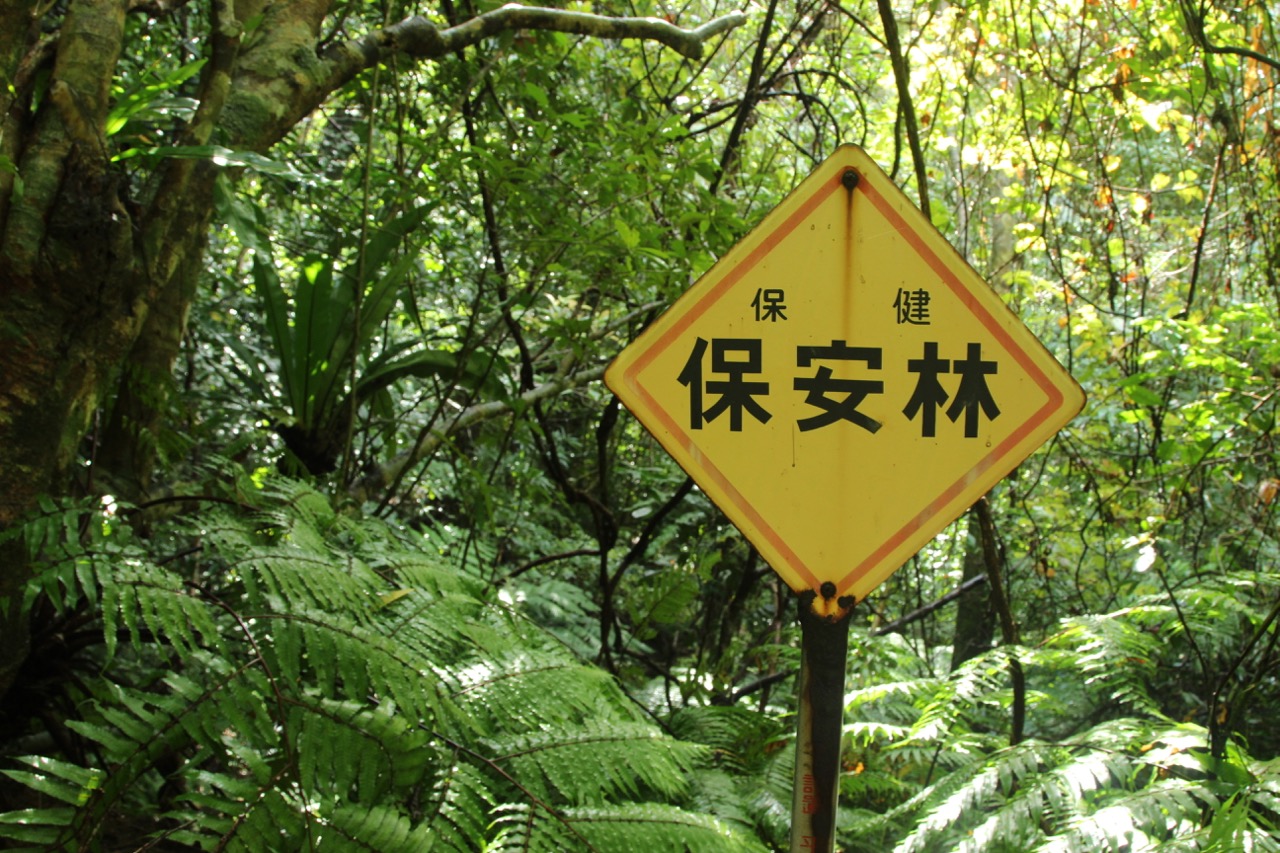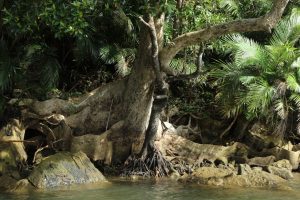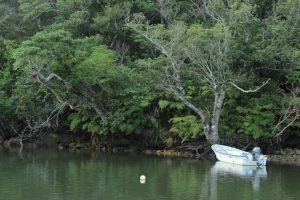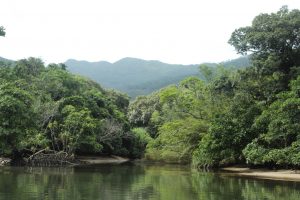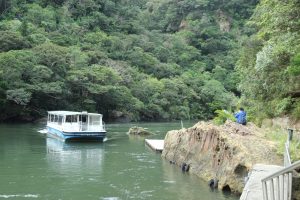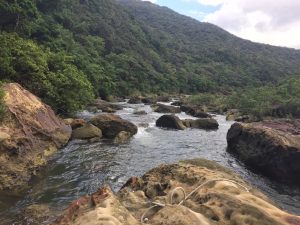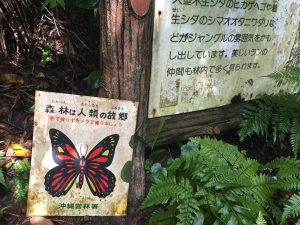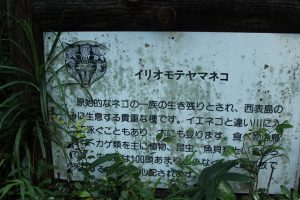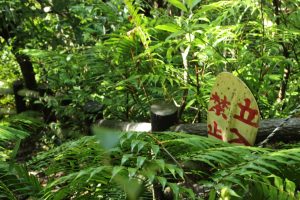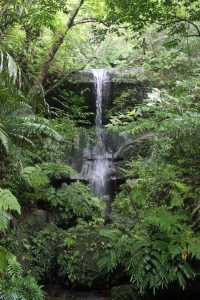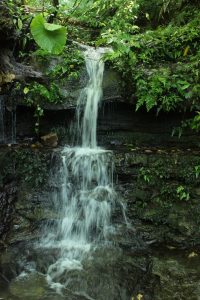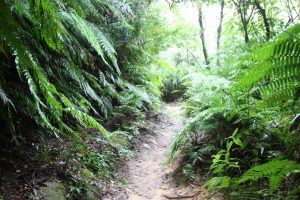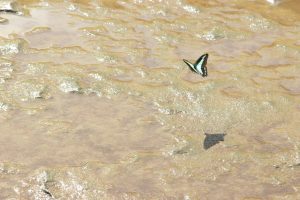It takes me an obscene amount of search refinements and a frustratingly long time to search for flora and fauna on this island. Maybe my google-fu is weak, but it took me ages to find out that the weird pineapple-y things we’ve been seeing around the island were screw pines. All the plant and animal identifiers I was finding in search did not apply to our remote corner of the world, and unless I put in more effort than I felt like putting in to search in Japanese, I would probably not find the information I sought.
Enough with that: today I picked up the Field Guide to Iriomote, which I had seen in the gift shop near our lunch restaurant yesterday. I am going to learn all the animal vocabulary and I will finally be able to figure out what the world around me is! Perfect timing for our jungle river cruise.

Today we went for our Urauchi River jungle cruise and trek: a half hour cruise up the river, followed by a trip to the island’s waterfalls, and then a half hour cruise back.
I had forgotten my rule from 2007: when it comes to some kind of outdoor activity, do what the Japanese people are doing. Do they all have umbrellas? Probably take yours (although they are very sensitive to “it might rain” and will raise umbrellas at the slightest provocation). Are they all collecting rain boots from the cruise main office? Probably do this thing too.
We decided to skip the rain boots and climbed aboard our boat up the river. The river is lined with mangrove trees, creating habitats for the river fish and mammals of the island. We zipped up the river until it became impassable to our boat, catching a glimpse of the island’s wild boar and a crane on the way. We also saw some more foreigners (in our boat), which is a bit weird to us since there don’t seem to be many others here at all.
We disembarked at a rocky pier and started up a surprisingly well-paved trail. Silly people with rainboots, I thought. This isn’t muddy at all! After about ten minutes, however, this became very much not the case. Paved rocks gave way to stone steps, which gave way to tan dirt, which of course, became mud.
It wasn’t your average slightly mucky trail, it was serious mud, like the kind you find in a dog park after it’s rained heavily and all your local dogs have had a gleeful romp through inches of thick muck.

Fortunately, most of the mud could be circumnavigated if you were a mud-avoiding ninja. Some of it was cradled between hoppable rocks, and some of it was in a mud canyon where you could rapidly wall jump like a ninja warrior if you were determined to not touch the mud and moderately coordinated to avoid falling off the cliff.
I was determined. I was a ninja warrior! I hopped over most of the mud and only ended up accidentally squishing into mud twice. Fortunately, I had been wise enough to wear my running socks on this day, so my feet didn’t stay wet for long. My shoes did not enter soggy waffle state.

The path was very jurassic park, surrounded by fern trees, ferns, and at one point, a giant fence we assumed was used to hold back the raptors. The trail had many signs proclaiming its protected forest state, as over 75% of the island is protected state land. There were areas where the path narrowed to about six inches wide with a rapid drop off on one side. We lived, and didn’t slip and die.
After about forty minutes, we reached the Kanpiree waterfall. It was a wide stretch of rapids, fed into by some slippery streams that we could walk through. I fell on my butt exactly once and basked in sun on the rocks while enjoying the roar of the falls.
On our trip up the river, they introduced us to a few places that had been a town in the late 60s before rainfall and flooding forced the villagers to abandon the coal mines and mills. At one point, we passed through the deepest part of the river, which is darkly known as the Three Puppies. As local legends have it, a man swam across the river behind his three puppies. At the deepest point, a shadow swam up and ate all of the puppies D: He lived to tell the tale…of river sharks!
We did not get eaten by sharks (thankfully), and drove back to our favorite lunch spot. We had noticed a lookout point from our beach near our lunch spot, so we drove around some questionable roads until we located the lookout point.

The view over the bay was spectacular, and the sun was attempting to poke through the clouds. I had started to forget what this sky orb was over the past few days.


The rest of the day was spent flopped on the beach, reading and wading in the water to get the mud off my pants. I think I even got a little bit of a tan!
Thanks to the book, I identified some of the animals I had seen:
- The coconut crab (he feeds on the screw pines)
- The tree with no name in english that I’m going to call the Ribbon Mangrove
- The beautiful Chinese windmill butterfly
- The common tiger butterfly, which looks like a monarch but is not
- The smooth-handed ghost crab, which lives in blast holes on the beach and is not creepy as the name suggests
- The Yaeyama harpist frog which has an amazing cry
- At least six types of heron, including the ground heron and the intermediate heron (the taxonomist was just lazy with that one)
Tomorrow is our last morning on Iriomote. The island is beginning to fill in for the weekend, with tour buses noisily shuttling passengers between locations more frequently than the entire first part of our trip combined. We saw more foreigners, confirming my suspicion that you really didn’t come out here unless you had a guided English tour or you spoke Japanese.
At least we got to see the sunset and stars tonight! I macguyvered a tripod for my camera out of a flip flop and driftwood in a valiant effort to get a picture of the stars. Without lots of processing, nothing can do them justice. The stars blaze out here on this tiny island of 2000 people, free from light pollution and highway noise.


Tomorrow, we will explore a few more things around the island, like an oxcart tour, and then we’ll go back to Ishigaki in the first part of our journey back to Tokyo.
